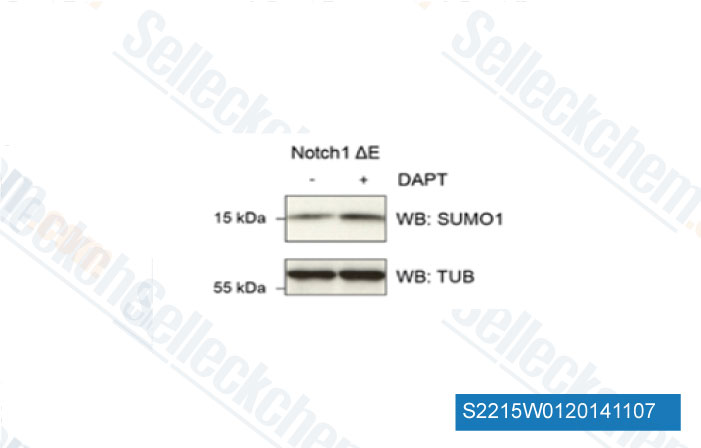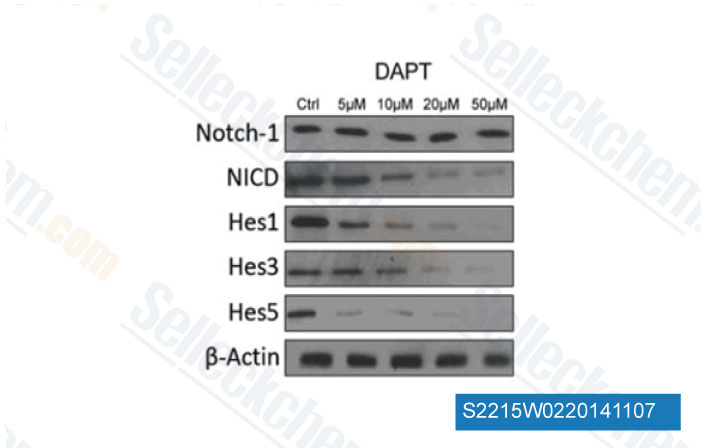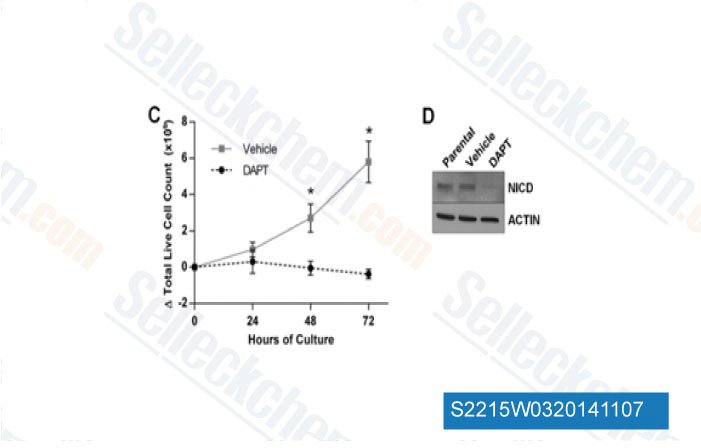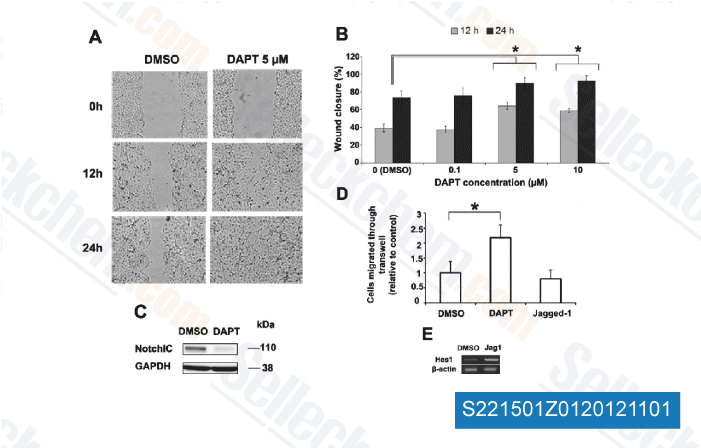|
Toll Free: (877) 796-6397 -- USA and Canada only -- |
Fax: +1-832-582-8590 Orders: +1-832-582-8158 |
Tech Support: +1-832-582-8158 Ext:3 Please provide your Order Number in the email. |
Technical Data
| Formula | C23H26F2N2O4 |
||||||
| Molecular Weight | 432.46 | CAS No. | 208255-80-5 | ||||
| Solubility (25°C)* | In vitro | DMSO | 86 mg/mL (198.86 mM) | ||||
| Ethanol | 86 mg/mL (198.86 mM) | ||||||
| Water | Insoluble | ||||||
| In vivo (Add solvents to the product individually and in order) |
|
||||||
|
* <1 mg/ml means slightly soluble or insoluble. * Please note that Selleck tests the solubility of all compounds in-house, and the actual solubility may differ slightly from published values. This is normal and is due to slight batch-to-batch variations. * Room temperature shipping (Stability testing shows this product can be shipped without any cooling measures.) |
|||||||
Preparing Stock Solutions
Biological Activity
| Description | DAPT is a novel γ-secretase inhibitor, which inhibits Aβ production with IC50 of 20 nM in HEK 293 cells. DAPT enhances the apoptosis of human tongue carcinoma cells and regulates autophagy. | ||||
|---|---|---|---|---|---|
| Targets |
|
||||
| In vitro | In human primary neuronal cultures, DAPT also shows inhibitory effects on Aβ production with IC50 of 115 nM and 200 nM respectively for Aβ total and Aβ42, which is 5-10-fold lower than is observed in HEK 293 cells. [1] A recent study shows that DAPT inhibits the proliferation of SK-MES-1 cells in a concentration-dependent manner with IC50 of 11.3 μM. In addition, DAPT also induces caspase-dependent and caspase-independent apoptosis in lung squamous cell carcinoma cells by inhibiting Notch receptor signaling pathway. [2] | ||||
| In vivo | DAPT administration (100mg/kg) leads to a robust and sustained pharmacodynamic effect in PDAPP mice that DAPT levels in the brain exceeds 100 ng/g within 1 hour and persists up to 18 hours after administration, with peak levels of 490 ng/g observed after 3 hour. And during the period, DAPT (100 mg/kg) also reduces the cortical total Aβ and Aβ42 in a dose-dependent manner with a 50% reduction. [1] In rat cerebral cortexes, DAPT (40 mg/kg) suppresses the LPS-induced activity of γ-secretase and increases the cell apoptosis with the prolonged neuroinflammation. [3] |
Protocol (from reference)
| Kinase Assay:[1] |
|
|---|---|
| Cell Assay:[2] |
|
| Animal Study:[1] |
|
References
|
Customer Product Validation

-
Data from [Data independently produced by Oncogene, 2014, 10.1038/onc.2014.319]

-
Data from [Data independently produced by Stem Cells, 2014, 32(1), 301-12]

-
Data from [Data independently produced by Dis Model Mech, 2013, 6(6), 1494-506]

-
Data from [Invest Ophth Vis Sci, 2012, 53,12 ]
Selleck's DAPT has been cited by 440 publications
| Innate immune sensing of rotavirus by intestinal epithelial cells leads to diarrhea [ Cell Host Microbe, 2025, 33(3):408-419.e8] | PubMed: 40037352 |
| Spatiotemporal dynamics of early oogenesis in pigs [ Genome Biol, 2025, 26(1):2] | PubMed: 39748324 |
| Neutrophil extracellular traps-triggered hepatocellular senescence exacerbates lipotoxicity in non-alcoholic steatohepatitis [ J Adv Res, 2025, S2090-1232(25)00175-4] | PubMed: 40068761 |
| Mapping multimodal phenotypes to perturbations in cells and tissue with CRISPRmap [ Nat Biotechnol, 2024, 10.1038/s41587-024-02386-x] | PubMed: 39375448 |
| Nuclear localization of MTHFD2 is required for correct mitosis progression [ Nat Commun, 2024, 15(1):9529] | PubMed: 39532843 |
| Pericyte phenotype switching alleviates immunosuppression and sensitizes vascularized tumors to immunotherapy in preclinical models [ J Clin Invest, 2024, 134(18)e179860] | PubMed: 39286984 |
| Mechanosensitive protein polycystin-1 promotes periosteal stem/progenitor cells osteochondral differentiation in fracture healing [ Theranostics, 2024, 14(6):2544-2559] | PubMed: 38646641 |
| HiHo-AID2: boosting homozygous knock-in efficiency enables robust generation of human auxin-inducible degron cells [ Genome Biol, 2024, 25(1):58] | PubMed: 38409044 |
| High glutamine increases stroke risk by inducing the endothelial-to-mesenchymal transition in moyamoya disease [ MedComm (2020), 2024, 5(5):e525] | PubMed: 38628905 |
| Immune evasion in lung metastasis of leiomyosarcoma: upregulation of EPCAM inhibits CD8+ T cell infiltration [ Br J Cancer, 2024, 10.1038/s41416-024-02576-z] | PubMed: 38291183 |
RETURN POLICY
Selleck Chemical’s Unconditional Return Policy ensures a smooth online shopping experience for our customers. If you are in any way unsatisfied with your purchase, you may return any item(s) within 7 days of receiving it. In the event of product quality issues, either protocol related or product related problems, you may return any item(s) within 365 days from the original purchase date. Please follow the instructions below when returning products.
SHIPPING AND STORAGE
Selleck products are transported at room temperature. If you receive the product at room temperature, please rest assured, the Selleck Quality Inspection Department has conducted experiments to verify that the normal temperature placement of one month will not affect the biological activity of powder products. After collecting, please store the product according to the requirements described in the datasheet. Most Selleck products are stable under the recommended conditions.
NOT FOR HUMAN, VETERINARY DIAGNOSTIC OR THERAPEUTIC USE.
